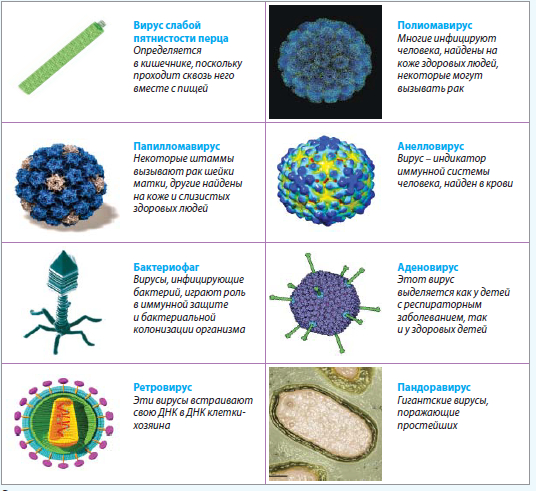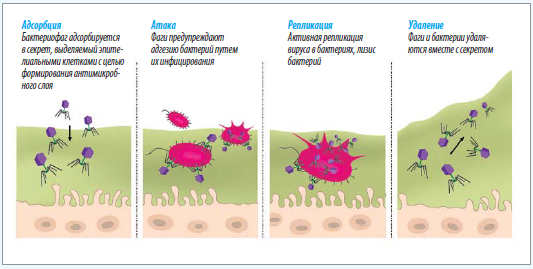Viral organisms as an important part of the human microflora
What is the “virome” of the human body and why is it important to maintain its balance?
Viruses are very mysterious microorganisms for science. In modern quarantine realities, the mention of the word “virus” causes anxiety and negativity, but in this article we will talk about the positive - about the symbiosis of the human body and viruses.
Inna Krulko , candidate of biological sciences, virologist, microbiologist (Ukraine)
Microflora concept
All systems of our body that are open to contact with the external environment are seeded with microorganisms and form the microflora of a healthy person. The human body is populated by more than 500 species of microorganisms that constitute normal microflora and are in a state of equilibrium (eubiosis) with each other and the body. In other words, microflora is a stable community of microorganisms, that is, a microbiocenosis. Normally, microorganisms are absent in the lungs and uterus. There are normal microflora of the skin, mucous membranes of the mouth, upper respiratory tract, digestive tract and genitourinary system.
The total number of microorganisms of the normal human flora reaches 1,014, which exceeds the number of cells of all tissues of an adult. The basis of normal microflora is anaerobic bacteria. In the intestines, the number of anaerobes is a thousand times greater than the number of aerobes.
The microflora of the skin is represented by various types of bacteria (staphylococci, streptococci, sarcina, diphtheroids), yeast fungi, and microscopic mites.
The microflora of the nasopharynx is usually constant for a long time. It may include pathogenic types of bacteria: pneumococcus, hemolytic streptococcus, meningococcus.
The microflora of the oral cavity consists of micrococci, enterococci, streptococci, pneumococci, lactic acid bacteria, Escherichia coli, Proteus, diphtheroids, Leptospira, spirilla. The number of bacteria varies in different places in the oral cavity. The microflora changes depending on the condition of the gums, teeth, tonsils and nasopharynx.
The microflora of the stomach during its normal function is represented by a relatively small number of bacteria: the vast majority of them die under the influence of gastric acid. The exceptions are acid-fast and sporogenic bacteria. When the acidity of gastric juice decreases, sarcina, yeasts, etc. can develop.
There are more microorganisms in the small intestine than in the stomach; bifidobacteria, clostridia, eubacteria, lactobacilli, and anaerobic cocci are found here. The largest number of microorganisms accumulate in the large intestine.
Normal microflora performs a number of essential and vital functions for human health: antagonistic, digestive, immunogenic, vitamin-forming, metabolic, detoxifying, regulatory, genetic.
Human Virome
In recent years, the concept of human microflora has generated much serious debate. It turned out that bacteria, fungi and single-celled microorganisms are not the only “residents” of our body that work for the benefit of humans. Viruses are said to be the most numerous components of the normal human ecosystem.
Viruses are fairly simple non-cellular agents, consisting of genetic material and protein and additionally lipid-carbohydrate shells. Viruses can only reproduce inside living cells. Since their discovery by scientists Dmitry Ivanovsky and Martin Beyerinck in 1892–1898. viruses were considered exclusively as infectious agents leading to the lysis of bacteria or all kinds of diseases in plants, animals and humans. Now a new interpretation of the concept of “virus” has emerged, which, along with the pathogenic role of these agents, includes their role in symbiosis with humans.
Today, scientists count about 10 quintillion viral particles on the planet. This is the number 1 followed by 31 zeros, which is 10 times the number of bacteria on Earth. Also, the number of viruses prevails over the number of bacteria on the human body.
A special research project called the “Human Virome” has even begun in the USA, which, according to many scientists, will be a great discovery in understanding the human body and will be extremely important for the medicine of the future.
Of course, studying the viral composition of the human body turned out to be much more difficult than its bacterial component. All bacteria contain a characteristic gene encoding 16S RNA, which is a kind of bacterial marker sequence. Neither human DNA nor any other eukaryotic cell encodes this sequence (Fig. 1). Thus, thanks to this specific sequence, databases of most microbial organisms that make up the human microflora have been built.

Rice. 1
For viruses, everything is much more difficult due to the difficulties in cultivation and the labor-intensive research process, the lack or absence of recognition sequences. That is, the process of studying the human virome is now in its initial stages and still requires a lot of time and effort. Nevertheless, something has already been studied and proven. For example, microbiologist Forest Rohwer from the University of San Diego (USA) and colleagues conducted a study that resulted in evidence that viruses play a role in the formation of human immunity. The secretion secreted by the mucous membranes of the mouth, intestines, and respiratory tract is densely populated with both bacteria and bacteriophages (phages, bacterial viruses), which control the entry of foreign bacteria into the body. Thus, phages are able to attack pathogenic bacteria that are trying to overcome the mucous barrier on their way to the body. The results of these studies were published in the proceedings of the American Academy of Sciences in June 2013.
Microbiologist at the University of Pennsylvania (Philadelphia, USA) Frederic Bushman determined that no two people have the same set of viruses. Each person's virus is very different. In addition, each individual's virome is constantly changing, as viruses mutate regularly - up to 4% during a single experiment, according to Dr. Bushman.
Some bacteria can use phages to fight other bacteria for a place to colonize. Thus, it was shown that the intestinal bacterium Enterococcus faecalis carried the sequence of the Frankenstein bacteriophage in its genome. The bacterium was able to secrete a bacteriophage to inhibit the growth of other bacteria and successfully colonize the intestinal mucosa.
Stephen Quake, a geneticist from Stanford University (USA), studied the composition of the blood of 96 patients - organ recipients (heart and lungs). A large number of anelloviruses were found in the blood of patients. An interesting fact was that organisms in whose blood a reduced number of anelloviruses were found were more likely to reject transplanted organs, which indicated insufficient suppression of the patient’s immune system by medications. That is, in this case, viruses in the blood can be indicators of the state of the human immune system.
Viruses of the skin and mucous membranes
Human skin is a complex ecosystem, densely populated by heterogeneous microflora, which includes bacteria, fungi, microscopic mites and viruses. Now enough information has accumulated to state that every healthy person has his own set of viruses, which forms its own ecosystem of the skin (Fig. 2).

Rice. 2
Thus, functional metagenomic studies of skin samples showed that a large number of beta- and gamma-papilomaviruses persist in the superficial layers of the skin. In addition, viruses of the Polyomaviridae family, including the HPyV6 and HPyV7 viruses, were discovered. An important discovery was the discovery in the skin of most healthy individuals of Merkel cell polyomavirus, which is also isolated from Merkel carcinoma cells in patients with carcinoma. Viruses of the Circoviridae family of the Cyclovirus genus were found, namely TN9, PK5034, PK5222, NG12. Previously, these viruses were isolated from insects, chimpanzees, as well as goats, chickens, sheep and other farm animals. Viruses of the genus Roseolovirus and Alphatorquevirus have also been isolated, which are also present in the nasopharynx and gastrointestinal tract of humans [2].
As previously mentioned, bacteriophages were also found on the skin and mucous membranes, which play the role of defenders against the attack of pathogenic bacteria, infecting and leading to their lysis directly in the secretion secreted by epithelial cells (Fig. 3).

Rice. 3. The role of bacteriophages in the formation of the body’s protective layer against pathogenic bacteria
The role of viruses in symbiosis with humans
The physiological role of the viral microbiota of the human body has not yet been fully studied. As it turned out, viruses do not always cause harm and cause a certain disease. Many latent and asymptomatic viruses are present in the body all the time. Viruses are hypothesized to play a role in protecting the body from pathogenic bacteria and other viruses, aiding bacterial colonization of the body, transmitting genetic information, and systemically supporting the body's immune system.
Bibliography:
- 1. Virgin HW The Virome in Mammalian Physiology and Disease // Cell 157, March 27, 2014. – R. 142–150.
- 2. Foulongne V. Human Skin Microbiota: High Diversity of DNA Viruses Identified on the Human Skin by High Throughput Sequencing // PLOS, June 2012, Vol. 7, Issue 6. – R. 1–11.
- 3. Saey TH Beyond the Microbiome. The Vast Virome// Science News, January 11, 2014. – R. 18–21.
- 4. Barr JJ et al Bacteriophage adhering to mucus provide a non-host-derived immunity // PNAS, June 25, 2013, Vol. 110, No. 26. – R. 10,771–10,776.
First published in Les Nouvelles Esthetiques 2015/№2
